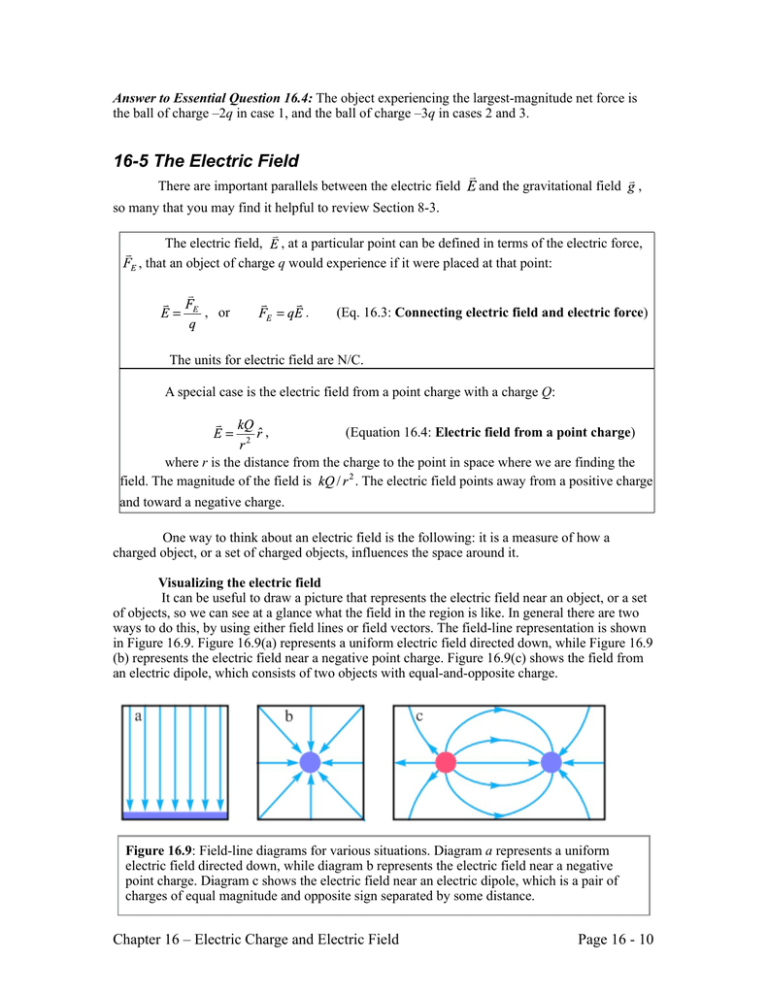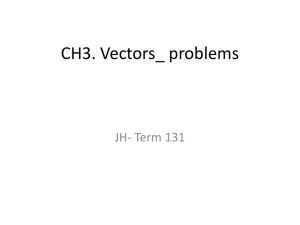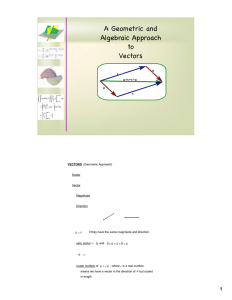16-5 The Electric Field
advertisement

Answer to Essential Question 16.4: The object experiencing the largest-magnitude net force is the ball of charge –2q in case 1, and the ball of charge –3q in cases 2 and 3. 16-5 The Electric Field There are important parallels between the electric field and the gravitational field , so many that you may find it helpful to review Section 8-3. The electric field, , at a particular point can be defined in terms of the electric force, , that an object of charge q would experience if it were placed at that point: , or . (Eq. 16.3: Connecting electric field and electric force) The units for electric field are N/C. A special case is the electric field from a point charge with a charge Q: , (Equation 16.4: Electric field from a point charge) where r is the distance from the charge to the point in space where we are finding the field. The magnitude of the field is . The electric field points away from a positive charge and toward a negative charge. One way to think about an electric field is the following: it is a measure of how a charged object, or a set of charged objects, influences the space around it. Visualizing the electric field It can be useful to draw a picture that represents the electric field near an object, or a set of objects, so we can see at a glance what the field in the region is like. In general there are two ways to do this, by using either field lines or field vectors. The field-line representation is shown in Figure 16.9. Figure 16.9(a) represents a uniform electric field directed down, while Figure 16.9 (b) represents the electric field near a negative point charge. Figure 16.9(c) shows the field from an electric dipole, which consists of two objects with equal-and-opposite charge. Figure 16.9: Field-line diagrams for various situations. Diagram a represents a uniform electric field directed down, while diagram b represents the electric field near a negative point charge. Diagram c shows the electric field near an electric dipole, which is a pair of charges of equal magnitude and opposite sign separated by some distance. Chapter 16 – Electric Charge and Electric Field Page 16 - 10 Question: How is the direction of the field at a particular point shown on a field-line diagram? What indicates the relative strength of the field at a point on the field-line diagram? Answer: As with gravitational field lines, each field line has a direction marked on it with an arrow that shows the direction of the electric field at all points along the field line. The relative strength of the field is indicated by the density of the field lines (that is, by how close the lines are). The more lines there are in a given area, the larger the field. A second method of representing a field is to use field vectors. A field vector diagram reinforces the idea that every point in space has an electric field associated with it, because a grid made up of equally spaced dots is superimposed on the picture and a vector is attached to each of these grid points. All the vectors are the same length. The situations represented by the field-line patterns in Figure 16.9 are now re-drawn in Figure 16.10 using the field-vector representation. Figure 16.10: Field-vector diagrams for various situations. In figure a, the field is uniform and directed down. Figure b represents the non-uniform but symmetric field found near a negative point charge, while figure c shows field vectors for an electric dipole. Question: How is the direction of the field at a particular point shown on a field-vector diagram? What indicates the relative strength of the field at a point on the field-vector diagram? Answer: The direction of the field at a particular point is represented by the direction of the field vector at that point (or the ones near it if the point does not correspond exactly to the location of a field vector). The relative strength of the field is indicated by the darkness of the arrow. The larger the magnitude of the field the darker the arrow. Related End of Chapter Exercises: 25, 26, 58. We often use a test charge to sample the electric field near a charge or a set of charges. A test charge is a positive charge of such a small magnitude that it has negligible impact on the field it is sampling. Based on the relationship , the force on a positive test charge is in the direction of the electric field at the point where the test charge is, and the size of the force is proportional to the magnitude of the field at that point. Essential Question 16.5: Figure 16.11 shows the force a positive test charge feels when it is placed at the location shown, near two charged balls. The ball on the left has a positive charge +Q, while the ball on the right has an unknown sign and magnitude. Based on the force experienced by the test charge, what is the sign of the charge on the ball on the right? How does the Figure 16.11: The arrow shows the force magnitude of that charge compare to Q? experienced by a test charge when it is placed at the position shown near two charged balls. Chapter 16 – Electric Charge and Electric Field Page 16 - 11




